Macroeconomic Analysis of Canada's GDP Growth Rate - Economics Report
VerifiedAdded on 2021/04/24
|9
|1536
|55
Report
AI Summary
This report provides a macroeconomic analysis of Canada's GDP growth, focusing on the impact of household spending as detailed in a Bloomberg news article from March 2018. The analysis identifies key macroeconomic concepts, such as GDP, consumption, investment, and aggregate demand, and explains their interrelations. The report examines how a decline in household spending affected Canada's GDP growth in the second half of 2017, leading to reduced consumer spending and lower inventory additions. It connects these findings to the 'Economic Way of Thinking' and relates them to the two big economic questions of what, how, and for whom goods and services are produced, and whether self-interest or social interest drives economic choices. The report also includes a personal connection to the topic and provides relevant references.
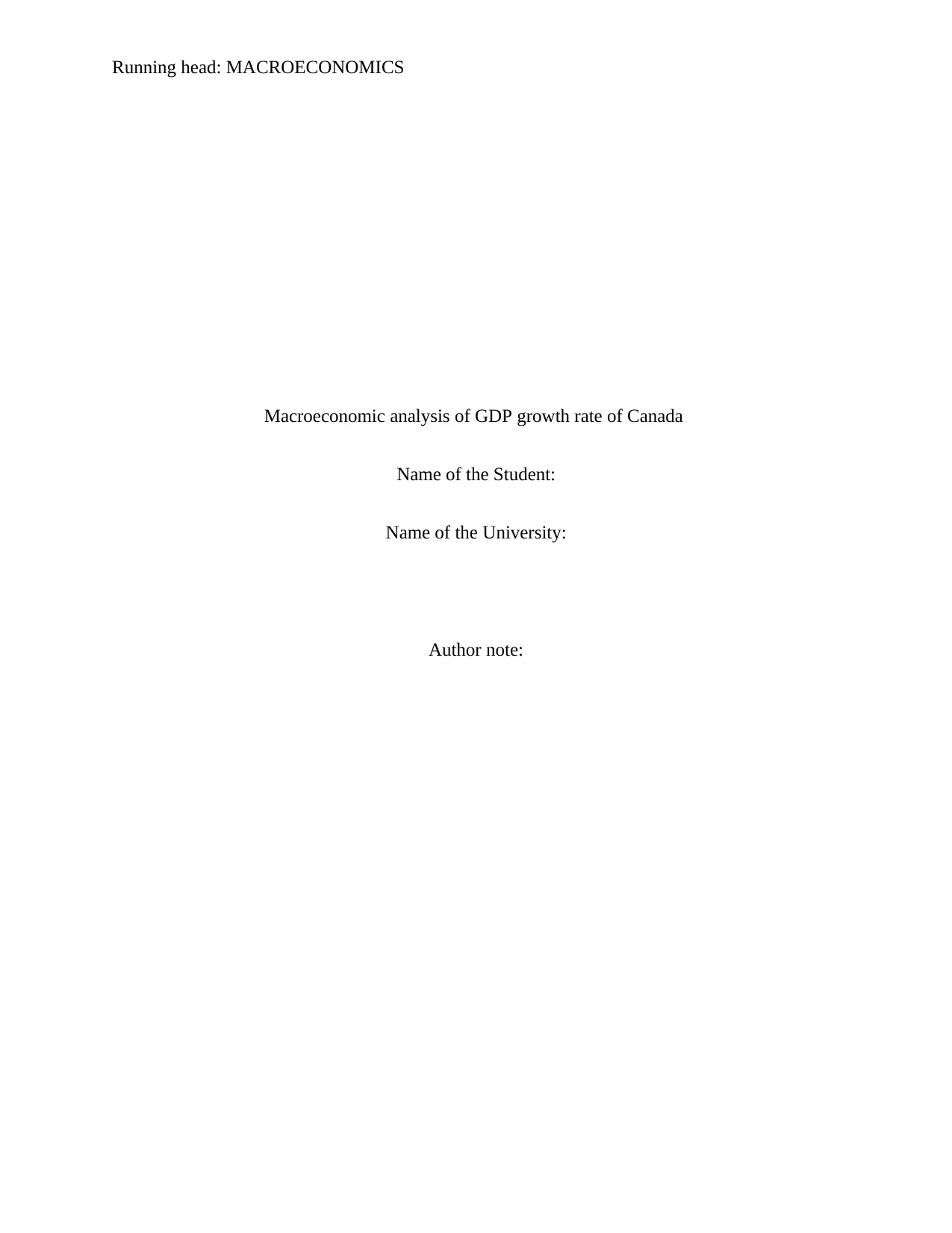
Running head: MACROECONOMICS
Macroeconomic analysis of GDP growth rate of Canada
Name of the Student:
Name of the University:
Author note:
Macroeconomic analysis of GDP growth rate of Canada
Name of the Student:
Name of the University:
Author note:
Paraphrase This Document
Need a fresh take? Get an instant paraphrase of this document with our AI Paraphraser
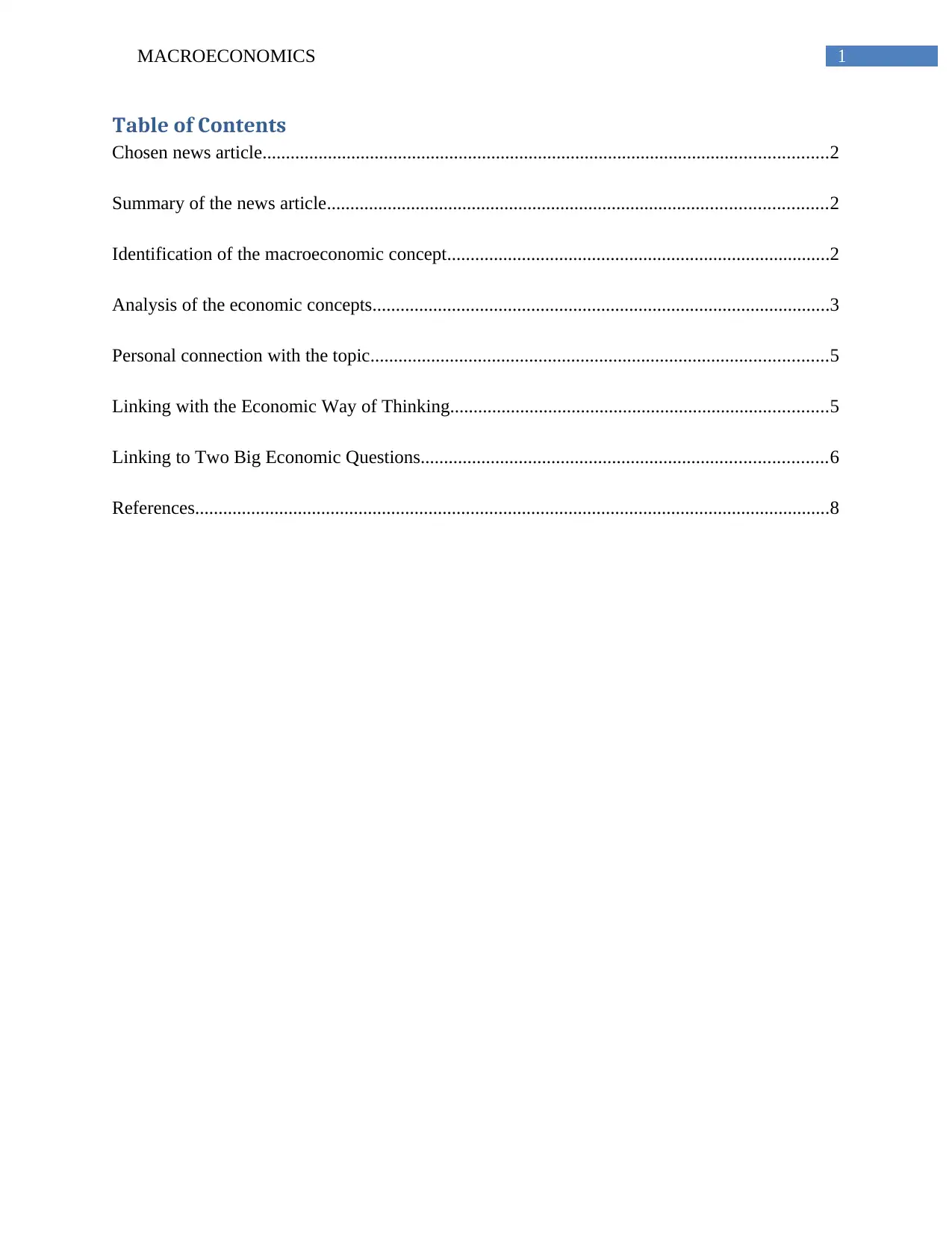
1MACROECONOMICS
Table of Contents
Chosen news article.........................................................................................................................2
Summary of the news article...........................................................................................................2
Identification of the macroeconomic concept..................................................................................2
Analysis of the economic concepts..................................................................................................3
Personal connection with the topic..................................................................................................5
Linking with the Economic Way of Thinking.................................................................................5
Linking to Two Big Economic Questions.......................................................................................6
References........................................................................................................................................8
Table of Contents
Chosen news article.........................................................................................................................2
Summary of the news article...........................................................................................................2
Identification of the macroeconomic concept..................................................................................2
Analysis of the economic concepts..................................................................................................3
Personal connection with the topic..................................................................................................5
Linking with the Economic Way of Thinking.................................................................................5
Linking to Two Big Economic Questions.......................................................................................6
References........................................................................................................................................8
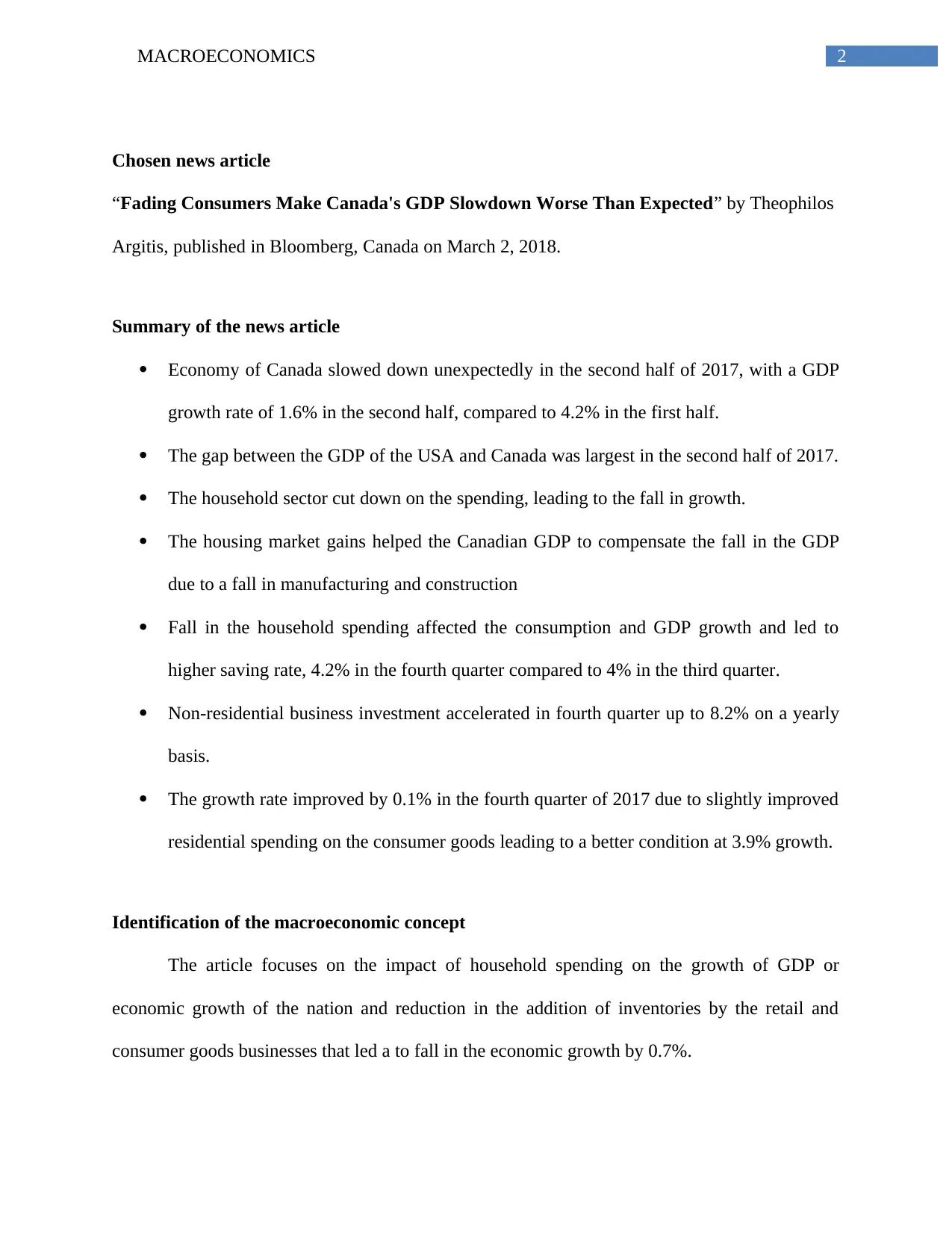
2MACROECONOMICS
Chosen news article
“Fading Consumers Make Canada's GDP Slowdown Worse Than Expected” by Theophilos
Argitis, published in Bloomberg, Canada on March 2, 2018.
Summary of the news article
Economy of Canada slowed down unexpectedly in the second half of 2017, with a GDP
growth rate of 1.6% in the second half, compared to 4.2% in the first half.
The gap between the GDP of the USA and Canada was largest in the second half of 2017.
The household sector cut down on the spending, leading to the fall in growth.
The housing market gains helped the Canadian GDP to compensate the fall in the GDP
due to a fall in manufacturing and construction
Fall in the household spending affected the consumption and GDP growth and led to
higher saving rate, 4.2% in the fourth quarter compared to 4% in the third quarter.
Non-residential business investment accelerated in fourth quarter up to 8.2% on a yearly
basis.
The growth rate improved by 0.1% in the fourth quarter of 2017 due to slightly improved
residential spending on the consumer goods leading to a better condition at 3.9% growth.
Identification of the macroeconomic concept
The article focuses on the impact of household spending on the growth of GDP or
economic growth of the nation and reduction in the addition of inventories by the retail and
consumer goods businesses that led a to fall in the economic growth by 0.7%.
Chosen news article
“Fading Consumers Make Canada's GDP Slowdown Worse Than Expected” by Theophilos
Argitis, published in Bloomberg, Canada on March 2, 2018.
Summary of the news article
Economy of Canada slowed down unexpectedly in the second half of 2017, with a GDP
growth rate of 1.6% in the second half, compared to 4.2% in the first half.
The gap between the GDP of the USA and Canada was largest in the second half of 2017.
The household sector cut down on the spending, leading to the fall in growth.
The housing market gains helped the Canadian GDP to compensate the fall in the GDP
due to a fall in manufacturing and construction
Fall in the household spending affected the consumption and GDP growth and led to
higher saving rate, 4.2% in the fourth quarter compared to 4% in the third quarter.
Non-residential business investment accelerated in fourth quarter up to 8.2% on a yearly
basis.
The growth rate improved by 0.1% in the fourth quarter of 2017 due to slightly improved
residential spending on the consumer goods leading to a better condition at 3.9% growth.
Identification of the macroeconomic concept
The article focuses on the impact of household spending on the growth of GDP or
economic growth of the nation and reduction in the addition of inventories by the retail and
consumer goods businesses that led a to fall in the economic growth by 0.7%.
⊘ This is a preview!⊘
Do you want full access?
Subscribe today to unlock all pages.

Trusted by 1+ million students worldwide
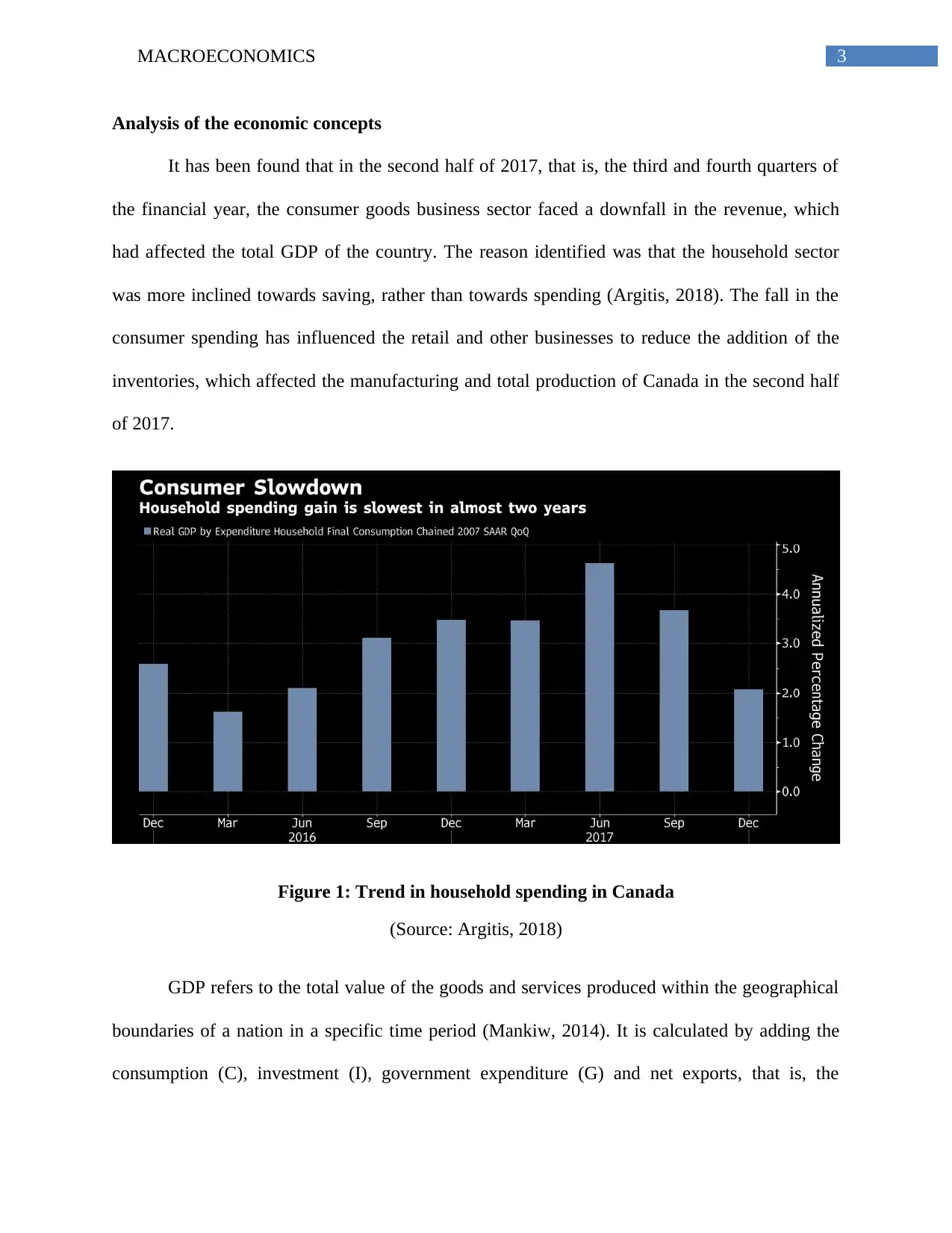
3MACROECONOMICS
Analysis of the economic concepts
It has been found that in the second half of 2017, that is, the third and fourth quarters of
the financial year, the consumer goods business sector faced a downfall in the revenue, which
had affected the total GDP of the country. The reason identified was that the household sector
was more inclined towards saving, rather than towards spending (Argitis, 2018). The fall in the
consumer spending has influenced the retail and other businesses to reduce the addition of the
inventories, which affected the manufacturing and total production of Canada in the second half
of 2017.
Figure 1: Trend in household spending in Canada
(Source: Argitis, 2018)
GDP refers to the total value of the goods and services produced within the geographical
boundaries of a nation in a specific time period (Mankiw, 2014). It is calculated by adding the
consumption (C), investment (I), government expenditure (G) and net exports, that is, the
Analysis of the economic concepts
It has been found that in the second half of 2017, that is, the third and fourth quarters of
the financial year, the consumer goods business sector faced a downfall in the revenue, which
had affected the total GDP of the country. The reason identified was that the household sector
was more inclined towards saving, rather than towards spending (Argitis, 2018). The fall in the
consumer spending has influenced the retail and other businesses to reduce the addition of the
inventories, which affected the manufacturing and total production of Canada in the second half
of 2017.
Figure 1: Trend in household spending in Canada
(Source: Argitis, 2018)
GDP refers to the total value of the goods and services produced within the geographical
boundaries of a nation in a specific time period (Mankiw, 2014). It is calculated by adding the
consumption (C), investment (I), government expenditure (G) and net exports, that is, the
Paraphrase This Document
Need a fresh take? Get an instant paraphrase of this document with our AI Paraphraser
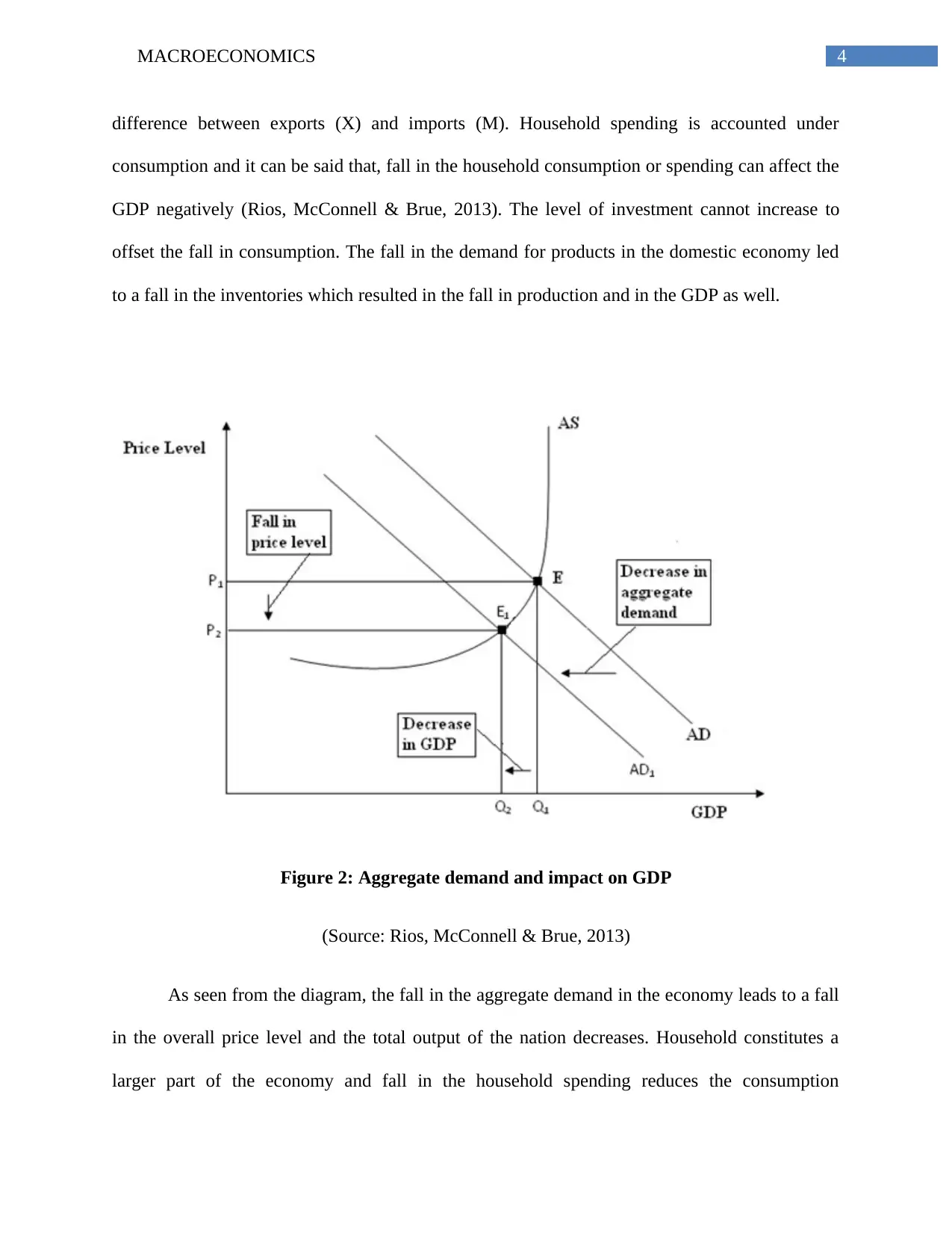
4MACROECONOMICS
difference between exports (X) and imports (M). Household spending is accounted under
consumption and it can be said that, fall in the household consumption or spending can affect the
GDP negatively (Rios, McConnell & Brue, 2013). The level of investment cannot increase to
offset the fall in consumption. The fall in the demand for products in the domestic economy led
to a fall in the inventories which resulted in the fall in production and in the GDP as well.
Figure 2: Aggregate demand and impact on GDP
(Source: Rios, McConnell & Brue, 2013)
As seen from the diagram, the fall in the aggregate demand in the economy leads to a fall
in the overall price level and the total output of the nation decreases. Household constitutes a
larger part of the economy and fall in the household spending reduces the consumption
difference between exports (X) and imports (M). Household spending is accounted under
consumption and it can be said that, fall in the household consumption or spending can affect the
GDP negatively (Rios, McConnell & Brue, 2013). The level of investment cannot increase to
offset the fall in consumption. The fall in the demand for products in the domestic economy led
to a fall in the inventories which resulted in the fall in production and in the GDP as well.
Figure 2: Aggregate demand and impact on GDP
(Source: Rios, McConnell & Brue, 2013)
As seen from the diagram, the fall in the aggregate demand in the economy leads to a fall
in the overall price level and the total output of the nation decreases. Household constitutes a
larger part of the economy and fall in the household spending reduces the consumption
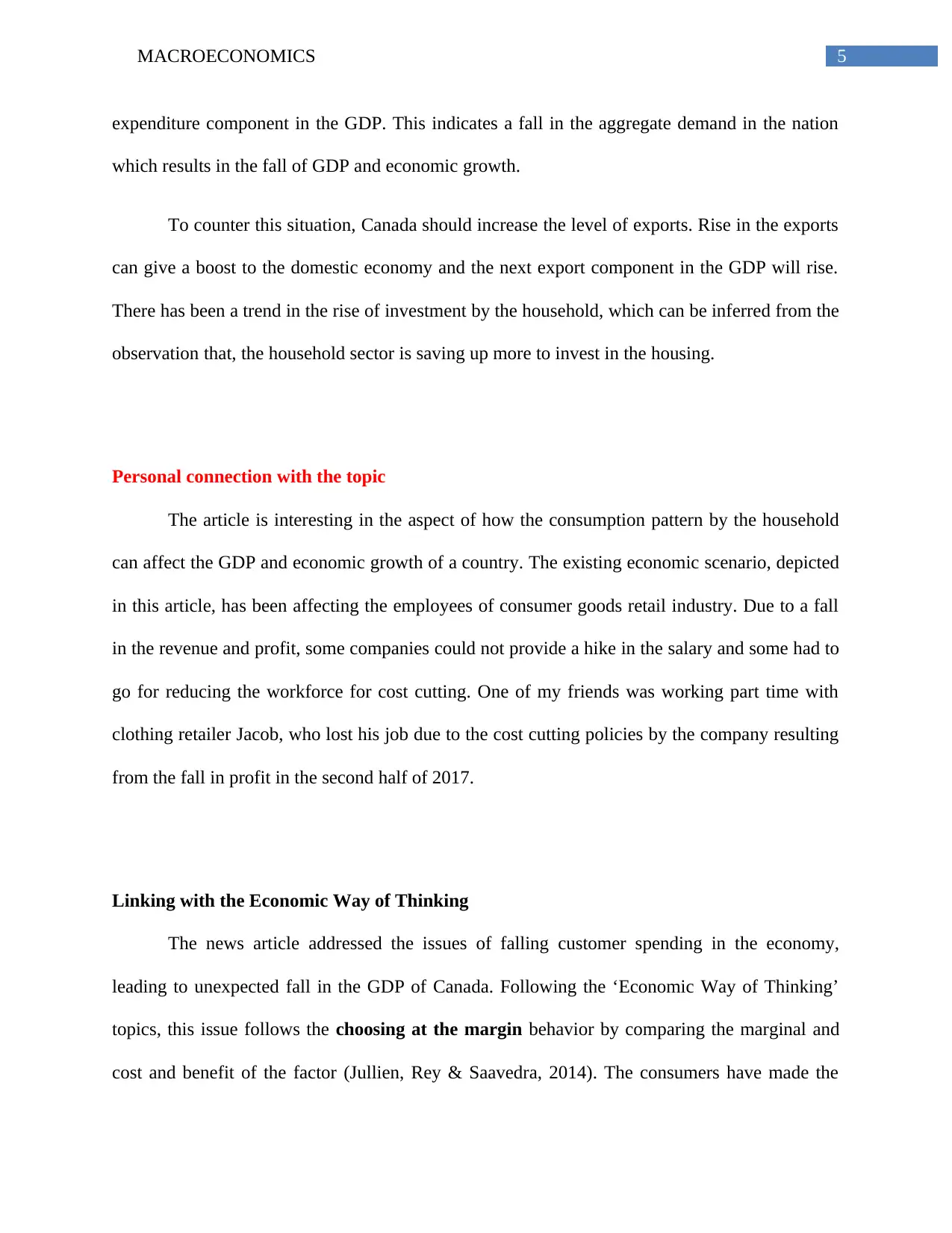
5MACROECONOMICS
expenditure component in the GDP. This indicates a fall in the aggregate demand in the nation
which results in the fall of GDP and economic growth.
To counter this situation, Canada should increase the level of exports. Rise in the exports
can give a boost to the domestic economy and the next export component in the GDP will rise.
There has been a trend in the rise of investment by the household, which can be inferred from the
observation that, the household sector is saving up more to invest in the housing.
Personal connection with the topic
The article is interesting in the aspect of how the consumption pattern by the household
can affect the GDP and economic growth of a country. The existing economic scenario, depicted
in this article, has been affecting the employees of consumer goods retail industry. Due to a fall
in the revenue and profit, some companies could not provide a hike in the salary and some had to
go for reducing the workforce for cost cutting. One of my friends was working part time with
clothing retailer Jacob, who lost his job due to the cost cutting policies by the company resulting
from the fall in profit in the second half of 2017.
Linking with the Economic Way of Thinking
The news article addressed the issues of falling customer spending in the economy,
leading to unexpected fall in the GDP of Canada. Following the ‘Economic Way of Thinking’
topics, this issue follows the choosing at the margin behavior by comparing the marginal and
cost and benefit of the factor (Jullien, Rey & Saavedra, 2014). The consumers have made the
expenditure component in the GDP. This indicates a fall in the aggregate demand in the nation
which results in the fall of GDP and economic growth.
To counter this situation, Canada should increase the level of exports. Rise in the exports
can give a boost to the domestic economy and the next export component in the GDP will rise.
There has been a trend in the rise of investment by the household, which can be inferred from the
observation that, the household sector is saving up more to invest in the housing.
Personal connection with the topic
The article is interesting in the aspect of how the consumption pattern by the household
can affect the GDP and economic growth of a country. The existing economic scenario, depicted
in this article, has been affecting the employees of consumer goods retail industry. Due to a fall
in the revenue and profit, some companies could not provide a hike in the salary and some had to
go for reducing the workforce for cost cutting. One of my friends was working part time with
clothing retailer Jacob, who lost his job due to the cost cutting policies by the company resulting
from the fall in profit in the second half of 2017.
Linking with the Economic Way of Thinking
The news article addressed the issues of falling customer spending in the economy,
leading to unexpected fall in the GDP of Canada. Following the ‘Economic Way of Thinking’
topics, this issue follows the choosing at the margin behavior by comparing the marginal and
cost and benefit of the factor (Jullien, Rey & Saavedra, 2014). The consumers have made the
⊘ This is a preview!⊘
Do you want full access?
Subscribe today to unlock all pages.

Trusted by 1+ million students worldwide
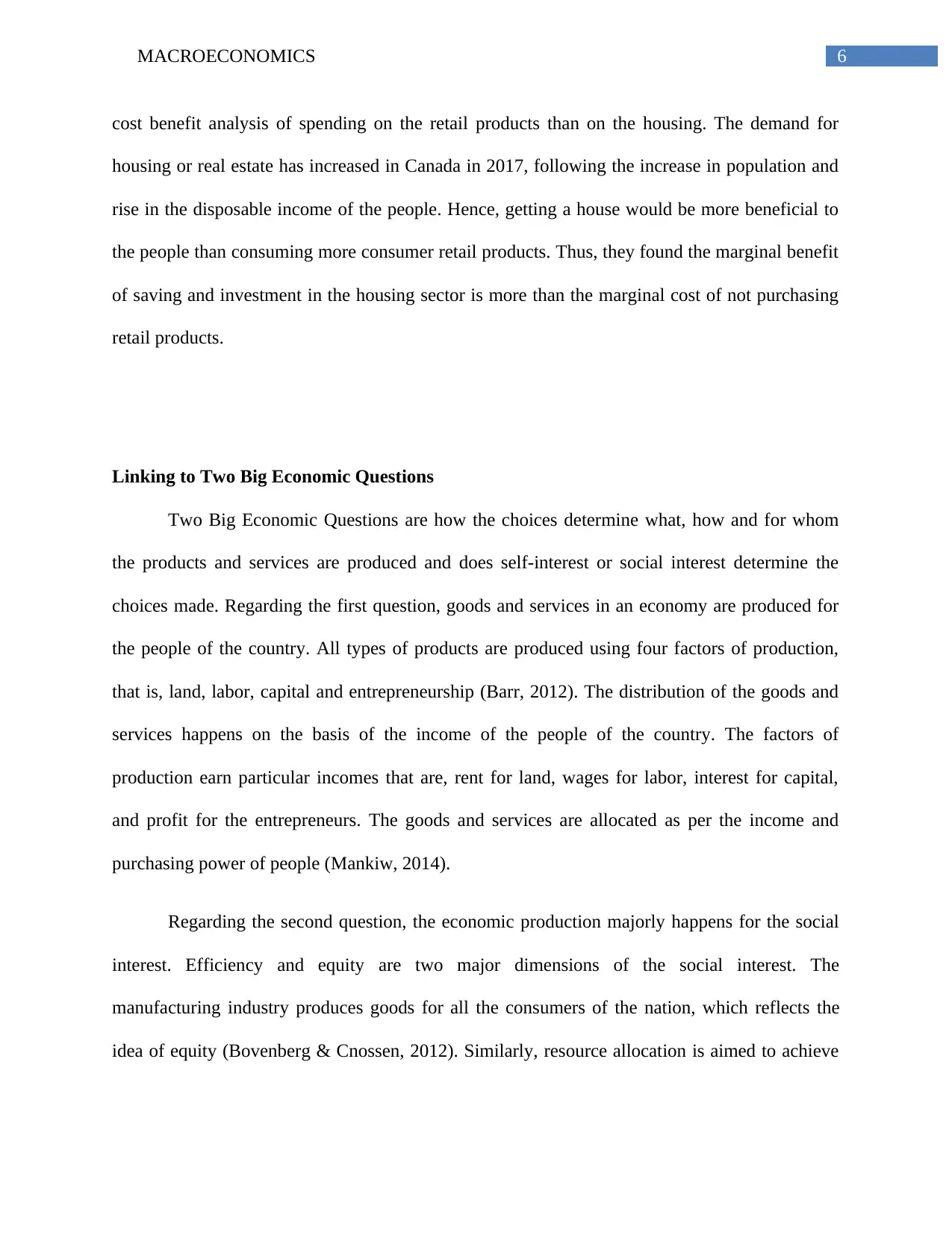
6MACROECONOMICS
cost benefit analysis of spending on the retail products than on the housing. The demand for
housing or real estate has increased in Canada in 2017, following the increase in population and
rise in the disposable income of the people. Hence, getting a house would be more beneficial to
the people than consuming more consumer retail products. Thus, they found the marginal benefit
of saving and investment in the housing sector is more than the marginal cost of not purchasing
retail products.
Linking to Two Big Economic Questions
Two Big Economic Questions are how the choices determine what, how and for whom
the products and services are produced and does self-interest or social interest determine the
choices made. Regarding the first question, goods and services in an economy are produced for
the people of the country. All types of products are produced using four factors of production,
that is, land, labor, capital and entrepreneurship (Barr, 2012). The distribution of the goods and
services happens on the basis of the income of the people of the country. The factors of
production earn particular incomes that are, rent for land, wages for labor, interest for capital,
and profit for the entrepreneurs. The goods and services are allocated as per the income and
purchasing power of people (Mankiw, 2014).
Regarding the second question, the economic production majorly happens for the social
interest. Efficiency and equity are two major dimensions of the social interest. The
manufacturing industry produces goods for all the consumers of the nation, which reflects the
idea of equity (Bovenberg & Cnossen, 2012). Similarly, resource allocation is aimed to achieve
cost benefit analysis of spending on the retail products than on the housing. The demand for
housing or real estate has increased in Canada in 2017, following the increase in population and
rise in the disposable income of the people. Hence, getting a house would be more beneficial to
the people than consuming more consumer retail products. Thus, they found the marginal benefit
of saving and investment in the housing sector is more than the marginal cost of not purchasing
retail products.
Linking to Two Big Economic Questions
Two Big Economic Questions are how the choices determine what, how and for whom
the products and services are produced and does self-interest or social interest determine the
choices made. Regarding the first question, goods and services in an economy are produced for
the people of the country. All types of products are produced using four factors of production,
that is, land, labor, capital and entrepreneurship (Barr, 2012). The distribution of the goods and
services happens on the basis of the income of the people of the country. The factors of
production earn particular incomes that are, rent for land, wages for labor, interest for capital,
and profit for the entrepreneurs. The goods and services are allocated as per the income and
purchasing power of people (Mankiw, 2014).
Regarding the second question, the economic production majorly happens for the social
interest. Efficiency and equity are two major dimensions of the social interest. The
manufacturing industry produces goods for all the consumers of the nation, which reflects the
idea of equity (Bovenberg & Cnossen, 2012). Similarly, resource allocation is aimed to achieve
Paraphrase This Document
Need a fresh take? Get an instant paraphrase of this document with our AI Paraphraser
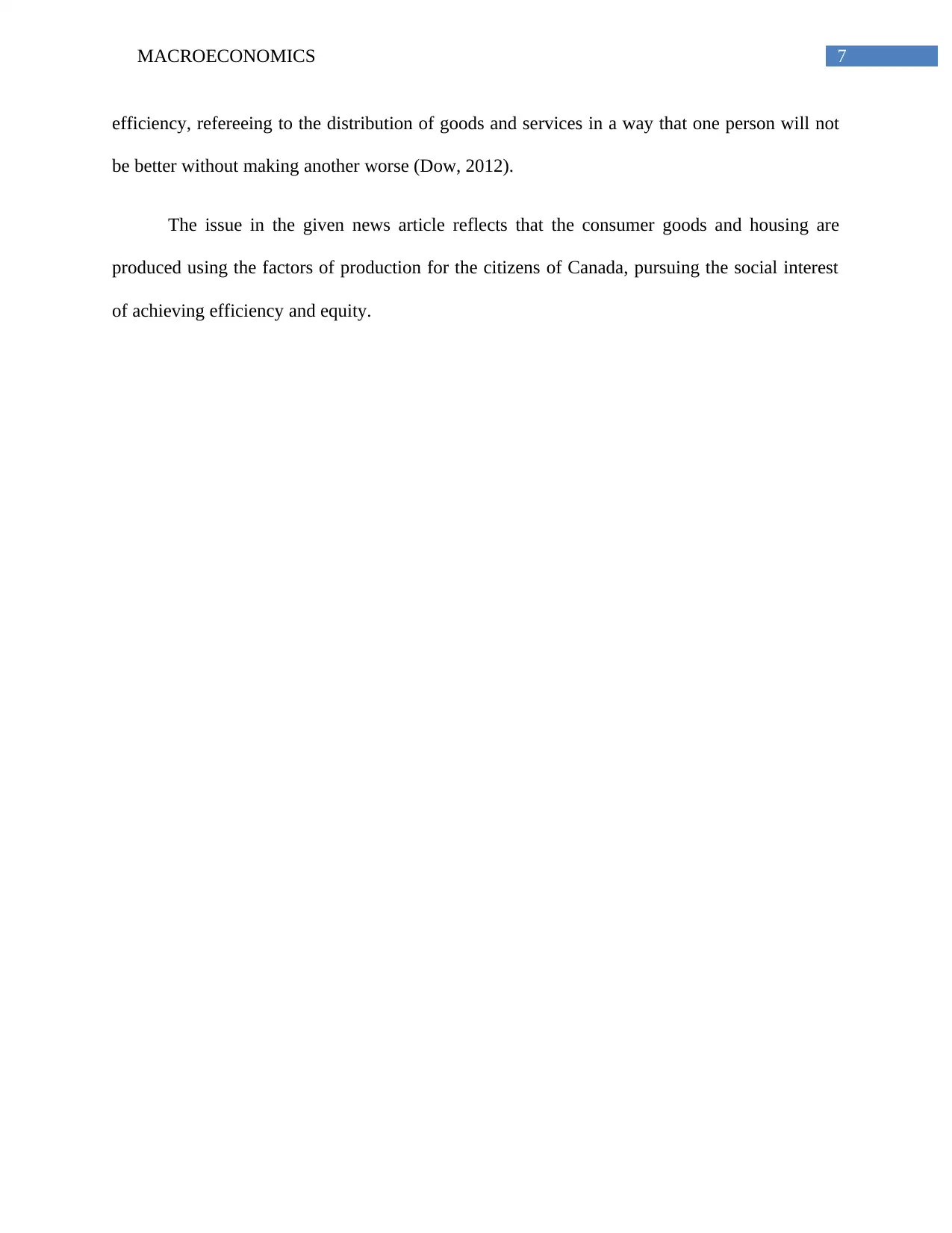
7MACROECONOMICS
efficiency, refereeing to the distribution of goods and services in a way that one person will not
be better without making another worse (Dow, 2012).
The issue in the given news article reflects that the consumer goods and housing are
produced using the factors of production for the citizens of Canada, pursuing the social interest
of achieving efficiency and equity.
efficiency, refereeing to the distribution of goods and services in a way that one person will not
be better without making another worse (Dow, 2012).
The issue in the given news article reflects that the consumer goods and housing are
produced using the factors of production for the citizens of Canada, pursuing the social interest
of achieving efficiency and equity.
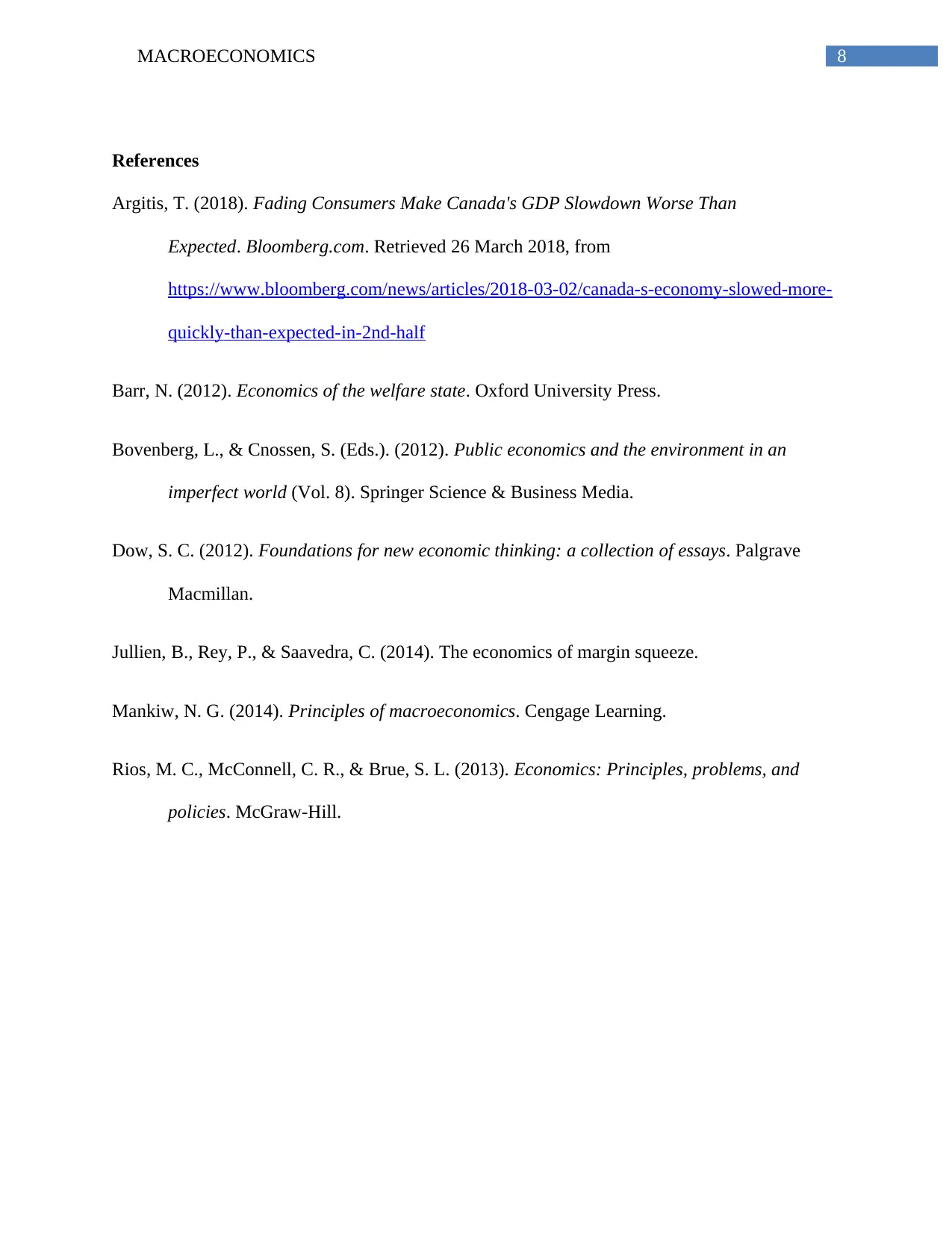
8MACROECONOMICS
References
Argitis, T. (2018). Fading Consumers Make Canada's GDP Slowdown Worse Than
Expected. Bloomberg.com. Retrieved 26 March 2018, from
https://www.bloomberg.com/news/articles/2018-03-02/canada-s-economy-slowed-more-
quickly-than-expected-in-2nd-half
Barr, N. (2012). Economics of the welfare state. Oxford University Press.
Bovenberg, L., & Cnossen, S. (Eds.). (2012). Public economics and the environment in an
imperfect world (Vol. 8). Springer Science & Business Media.
Dow, S. C. (2012). Foundations for new economic thinking: a collection of essays. Palgrave
Macmillan.
Jullien, B., Rey, P., & Saavedra, C. (2014). The economics of margin squeeze.
Mankiw, N. G. (2014). Principles of macroeconomics. Cengage Learning.
Rios, M. C., McConnell, C. R., & Brue, S. L. (2013). Economics: Principles, problems, and
policies. McGraw-Hill.
References
Argitis, T. (2018). Fading Consumers Make Canada's GDP Slowdown Worse Than
Expected. Bloomberg.com. Retrieved 26 March 2018, from
https://www.bloomberg.com/news/articles/2018-03-02/canada-s-economy-slowed-more-
quickly-than-expected-in-2nd-half
Barr, N. (2012). Economics of the welfare state. Oxford University Press.
Bovenberg, L., & Cnossen, S. (Eds.). (2012). Public economics and the environment in an
imperfect world (Vol. 8). Springer Science & Business Media.
Dow, S. C. (2012). Foundations for new economic thinking: a collection of essays. Palgrave
Macmillan.
Jullien, B., Rey, P., & Saavedra, C. (2014). The economics of margin squeeze.
Mankiw, N. G. (2014). Principles of macroeconomics. Cengage Learning.
Rios, M. C., McConnell, C. R., & Brue, S. L. (2013). Economics: Principles, problems, and
policies. McGraw-Hill.
⊘ This is a preview!⊘
Do you want full access?
Subscribe today to unlock all pages.

Trusted by 1+ million students worldwide
1 out of 9
Related Documents
Your All-in-One AI-Powered Toolkit for Academic Success.
+13062052269
info@desklib.com
Available 24*7 on WhatsApp / Email
![[object Object]](/_next/static/media/star-bottom.7253800d.svg)
Unlock your academic potential
Copyright © 2020–2025 A2Z Services. All Rights Reserved. Developed and managed by ZUCOL.





